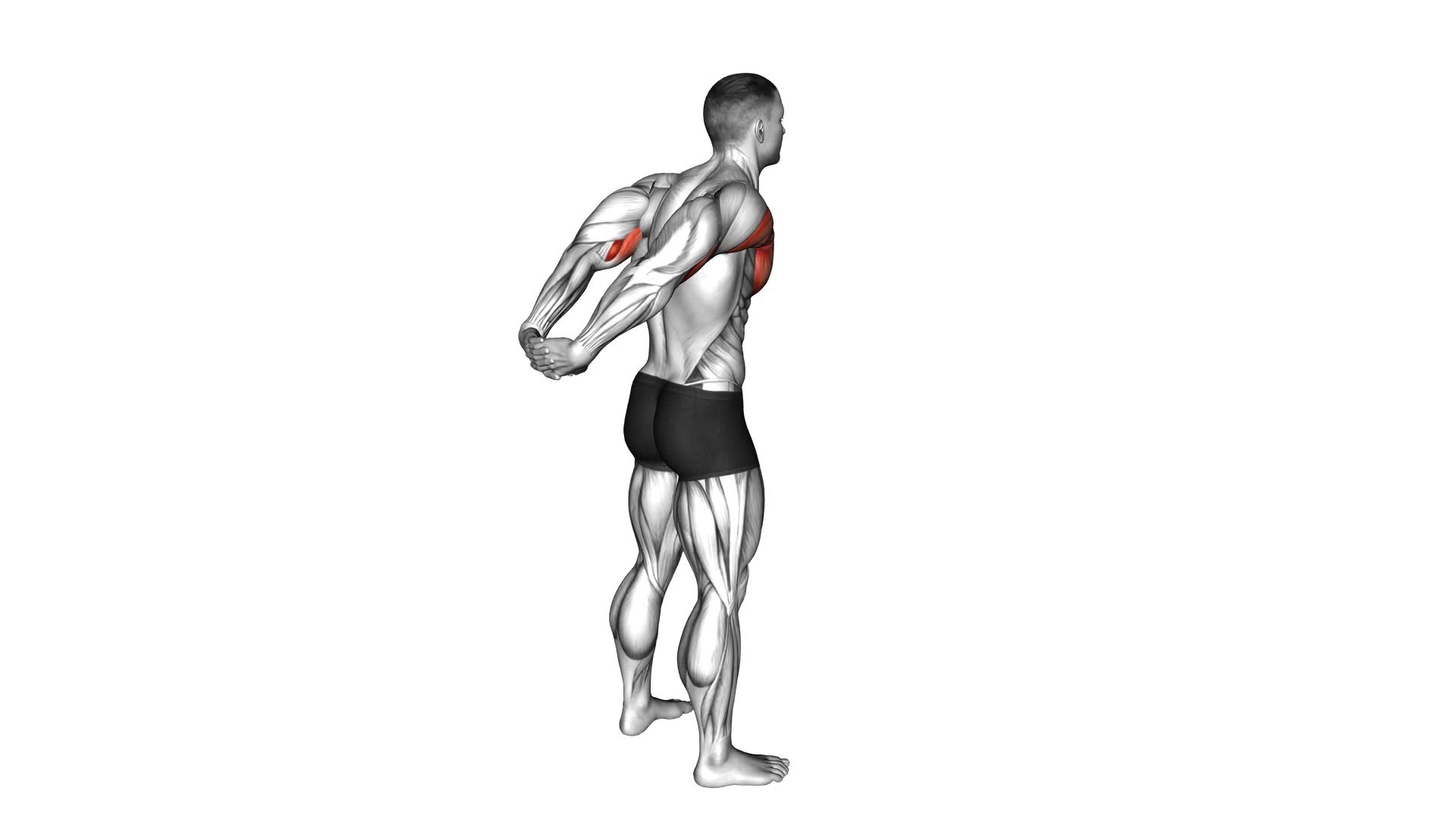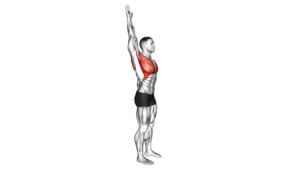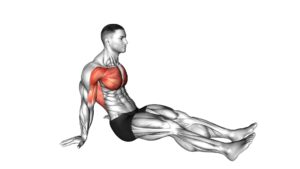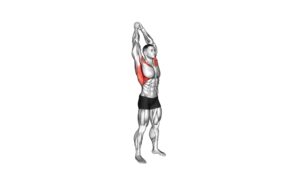Standing Reverse Shoulder Stretch – Video Exercise Guide & Tips

Get ready to improve your shoulder flexibility and relieve tension with the Standing Reverse Shoulder Stretch!
Watch This Exercise Video
This video exercise guide will show you the proper technique and common mistakes to avoid.
Plus, we'll share tips for increasing intensity and progressing in the stretch.
Whether you're a beginner or advanced, there are modifications and variations to suit your needs.
So grab a mat and get ready to stretch it out!
Key Takeaways
- The Standing Reverse Shoulder Stretch provides significant relief and improved flexibility in the shoulders.
- It is crucial for maintaining proper posture and preventing injuries.
- The stretch targets muscles such as the deltoids, trapezius, and rotator cuff muscles, alleviating tension and reducing the risk of shoulder pain and discomfort.
- Regular practice of the stretch leads to a wider range of motion, easier overhead reach, better performance in lifting movements, and reduced risk of shoulder pain and injury.
Benefits of the Standing Reverse Shoulder Stretch
You will experience significant relief and improved flexibility in your shoulders by regularly performing the Standing Reverse Shoulder Stretch. Shoulder flexibility is crucial for maintaining proper posture, preventing injuries, and performing daily activities with ease. Incorporating shoulder stretches into your daily routine is essential to maintain healthy shoulder joints and muscles.
The Standing Reverse Shoulder Stretch specifically targets the muscles in your shoulders, including the deltoids, trapezius, and rotator cuff muscles. By stretching these muscles, you can alleviate tension and tightness, reducing the risk of shoulder pain and discomfort.
In addition to relieving tension, this stretch also improves your shoulder flexibility. Increased flexibility allows for a wider range of motion, making it easier to reach overhead, perform lifting movements, and engage in sports or recreational activities.
To perform the Standing Reverse Shoulder Stretch, stand with your feet shoulder-width apart. Extend one arm straight across your chest, grabbing onto your opposite elbow with your other hand. Gently pull your arm towards your body until you feel a stretch in your shoulder. Hold for 20-30 seconds and repeat on the other side.
Incorporating the Standing Reverse Shoulder Stretch into your daily routine will help improve your shoulder flexibility and reduce the risk of shoulder pain and injury.
Proper Technique for the Standing Reverse Shoulder Stretch
To properly perform the Standing Reverse Shoulder Stretch, ensure that you stand with your feet shoulder-width apart and extend one arm straight across your chest, grabbing onto your opposite elbow with your other hand. This exercise is beneficial for improving shoulder flexibility and mobility.
Here are three key points to keep in mind while performing the stretch:
- Maintain good posture: Stand tall with your shoulders relaxed and your chest lifted. Avoid slouching or rounding your shoulders forward.
- Engage your core: Activate your abdominal muscles to stabilize your spine and support your posture during the stretch. This will help you maintain balance and prevent straining your lower back.
- Gentle and controlled movement: As you stretch your shoulder, avoid jerking or forcing the movement. Instead, move slowly and smoothly, allowing your shoulder muscles to gradually lengthen and relax.
Common Mistakes to Avoid During the Standing Reverse Shoulder Stretch
One common mistake to avoid during the Standing Reverse Shoulder Stretch is improper hand placement. Many people tend to place their hands too close together or too far apart, which can result in an ineffective stretch and potential strain on the shoulders. To ensure proper hand placement, start by standing tall with your feet shoulder-width apart. Extend your arms out to the sides at shoulder height, palms facing forward. From here, rotate your wrists so that your palms face behind you.
It's important to keep your hands shoulder-width apart throughout the exercise. Another mistake to avoid is rounding your shoulders forward. This can limit the effectiveness of the stretch and potentially cause discomfort. Instead, focus on keeping your shoulders pulled back and down throughout the entire movement.
Tips for Increasing Intensity and Progressing in the Standing Reverse Shoulder Stretch
To increase the intensity and progress in the Standing Reverse Shoulder Stretch, focus on gradually increasing the range of motion and holding the stretch for longer durations. This will help increase flexibility and strengthen the shoulders effectively.
Here are some tips to help you increase the intensity of the stretch and progress in your shoulder stretching routine:
- Gradually increase the range of motion: Start by performing the stretch within a comfortable range and gradually push your limits. As you become more flexible, try reaching further back with your hands and extending your arms higher overhead.
- Hold the stretch for longer durations: Initially, hold the stretch for 15-30 seconds and gradually increase the duration to 30-60 seconds. This will allow your muscles to adapt and improve their flexibility over time.
- Incorporate shoulder strengthening techniques: To enhance the effectiveness of the stretch, incorporate shoulder strengthening exercises into your routine. This can include exercises like shoulder presses, lateral raises, and rows, which will help build strength and stability in the shoulder muscles.
Modifications and Variations of the Standing Reverse Shoulder Stretch
When exploring modifications and variations of the Standing Reverse Shoulder Stretch, it's important to consider different ways to adapt the exercise to meet your specific needs and goals. Whether you're a beginner looking for a gentler approach or an advanced athlete seeking a greater challenge, there are options available to suit your fitness level.
One modification of the Standing Reverse Shoulder Stretch is to use a resistance band. Instead of clasping your hands behind your back, loop a resistance band around your wrists and pull it apart to create tension. This variation adds resistance to the stretch, making it more intense and engaging the muscles of the shoulders and upper back even further.
Another modification is to perform the stretch seated on a stability ball or a chair. This variation provides support and stability, making it ideal for individuals with balance issues or those recovering from an injury. By sitting down, you can still reap the benefits of the stretch without putting strain on your legs or lower back.
For those looking to take the Standing Reverse Shoulder Stretch to the next level, a variation is to perform the stretch with a towel or yoga strap. Hold the towel or strap with both hands behind your back and gradually increase the distance between your hands, deepening the stretch in the shoulders and chest.
Frequently Asked Questions
How Long Should I Hold the Standing Reverse Shoulder Stretch?
To improve flexibility and reap the benefits of shoulder stretches, it's important to know how long to hold the standing reverse shoulder stretch. While the duration may vary depending on your fitness level and comfort, a general guideline is to hold the stretch for about 20 to 30 seconds.
This allows enough time for the muscles to elongate and relax. Remember to breathe deeply and maintain proper form throughout the stretch for optimal results.
Can the Standing Reverse Shoulder Stretch Help Improve Posture?
Improving your posture is one of the benefits you can gain from incorporating the standing reverse shoulder stretch into your daily routine. This exercise helps stretch the muscles in your shoulders and upper back, which can help counteract the effects of poor posture.
To maintain proper form, remember to stand tall with your shoulders relaxed and gently pull your arm across your chest. By doing this stretch regularly, you can work towards better posture and alleviate tension in your upper body.
Is It Normal to Feel Discomfort or Tension During the Stretch?
Feeling discomfort or tension during the standing reverse shoulder stretch is normal. It's important to maintain proper form and technique to avoid injury.
Make sure to stand tall with your feet shoulder-width apart and your core engaged. Avoid rounding your shoulders or hunching forward.
Relax your neck and breathe deeply as you gently stretch your shoulders. Remember to listen to your body and stop if the discomfort becomes too intense.
Can I Perform the Standing Reverse Shoulder Stretch if I Have a Shoulder Injury?
If you have a shoulder injury, it's important to consult with a healthcare professional before attempting the standing reverse shoulder stretch. They can provide modifications or alternative exercises that are suitable for your condition.
The standing reverse shoulder stretch can be beneficial in a rehabilitation program for shoulder injuries as it helps to improve flexibility and range of motion. However, it's crucial to follow proper technique and listen to your body to avoid further injury or discomfort.
What Are Some Alternative Exercises That Target the Same Muscles as the Standing Reverse Shoulder Stretch?
If you're looking for alternative exercises that target the same shoulder muscles as the standing reverse shoulder stretch, there are a few options you can try. Some examples include lateral raises, bent-over rows, and shoulder presses.
These exercises can help strengthen and stretch your shoulder muscles, promoting better flexibility and mobility. Incorporating stretching exercises into your routine can have numerous benefits, such as reducing muscle tension, improving posture, and preventing injuries.
Conclusion
In conclusion, the standing reverse shoulder stretch is an effective exercise for stretching and strengthening the shoulder muscles. By following the proper technique and avoiding common mistakes, you can maximize the benefits of this stretch.
Additionally, there are various modifications and variations that can be incorporated to increase intensity and progress in the exercise.
Incorporating the standing reverse shoulder stretch into your workout routine can help improve shoulder mobility and reduce the risk of injuries.

Author
Years ago, the spark of my life’s passion ignited in my mind the moment I stepped into the local gym for the first time. The inaugural bead of perspiration, the initial endeavor, the very first surge of endorphins, and a sense of pride that washed over me post-workout marked the beginning of my deep-seated interest in strength sports, fitness, and sports nutrition. This very curiosity blossomed rapidly into a profound fascination, propelling me to earn a Master’s degree in Physical Education from the Academy of Physical Education in Krakow, followed by a Sports Manager diploma from the Jagiellonian University. My journey of growth led me to gain more specialized qualifications, such as being a certified personal trainer with a focus on sports dietetics, a lifeguard, and an instructor for wellness and corrective gymnastics. Theoretical knowledge paired seamlessly with practical experience, reinforcing my belief that the transformation of individuals under my guidance was also a reflection of my personal growth. This belief holds true even today. Each day, I strive to push the boundaries and explore new realms. These realms gently elevate me to greater heights. The unique combination of passion for my field and the continuous quest for growth fuels my drive to break new ground.







